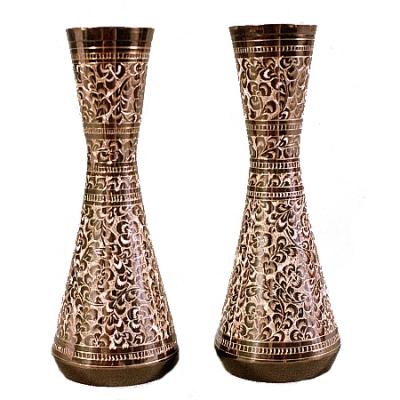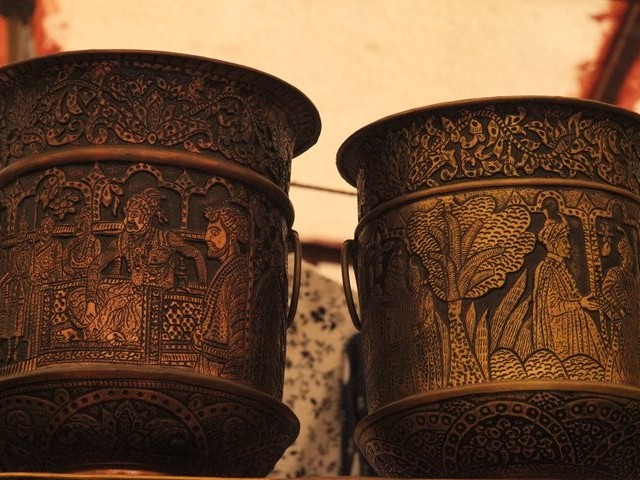For centuries, various metals have been used by man to create a great range of items that are put to different uses. The most popular metals are gold, silver, iron and copper, as well as alloys (mixture of two or more metals) such as bronze, brass and steel. Pakistan is one of the countries that has made its mark on the world with its unique handicrafts, and metal-ware is one of them.
History
The discovery of utensils, tools and other items made of copper, silver and bronze at Harappa, Mohenjo Daro and Taxila makes it clear that metal-ware was being crafted in the territory constituting Pakistan today. The eight-inch statuette dancing girl, a fragment of the foot with an anklet, a frying pan with a ram’s head on its handle, the Fasting Buddha are just some outstanding examples of artifacts found, which also tell us about the history of several dynasties. They are preserved in museums at Taxila, Peshawar and Lahore. Furthermore seven exquisite pieces made between the 4th and 19th century, in the Gandhara region, Lahore, Sialkot, Gujrat and Gilgit/Skardu are on display at the Los Angeles County Museum of Art.
Muslim Contribution
Muslims have also greatly contributed to the field of metal-ware. In South Asia the technological advancements were introduced from the 13th century and beyond, under the Ottomans, Safavids and the Mughals. They not only developed and enhanced the traditional methods of chasing/embossing(to imprint a design on the front), engraving (to carve a design), enameling (a process of amalgamating colorful glass into the design on a metal through heat) molding (a strip is used for decorative or finishing touches),repousse (to create a raised design by working on the backside of metal) and encrusting (to decorate by overlaying with a contrasting material), they also transformed metals into various shapes and gave ornamentation a whole new dimension as the motifs and designs in geometric, arabesque and floral were endless and had no parallel.

All the surviving bronze, brass and copper furniture, decorative objects and tools showcase the finesse of craftsmanship of that time. They perfected the art of damascening (which is inlaying designs with gold or silver on other metals such as steel, bronze or brass, and takes its name from Damascus where it was initiated). The Spanish, Iraqi and Egyptian style spread to Europe through Italy during the 15th century.
The metals most popularly used then were copper and iron. To make the use of copper utensils safer, they were frequently lined with tin. Peshawar and Lahore developed into major centers of coppersmiths craft. While iron was used for kitchen items such as tongs, fire-blower, tawas (covex plate for baking bread) and karahis (semi circle pans) as well as horse-shoes and weapons.
The city of Wazirabad, and town of Nizamabad in the Gujaranwala District were and still are the hub for making all kinds of knives for hunting, sporting, traditional household and general purposes as well as swords which are usually made of Damascus Steel. The handles and hilts are often engraved with inlays of silver and gold. While the iron-ore reserves at Khuzdar were the reason of the rise of iron-craft in Baluchistan and the frontier region was known for armor crafting.
Sterling Silverware was made by Buddhist blacksmiths who resided in the region now known as Kashmir. Then in the 14th century, the Muslims invaded and took over the craft. Muslim artisans made stunning items, and among the trademark patterns were the lilac flower and the chinar or lotus leaf. Others included calligraphic, geometric or conventional designs. Silverware was compulsory in the home decor of rich Kashmiri families and several items were essentially given as part the dowry such as tea-set, dishes, cutlery, glasses, candle-stands, bowls, paandaan, gulabposh (rosewater sprinkler), surma-dani etc.
Solid Gold items were used only by Monarchs & Aristocrats.
The Craft in Pakistan
It is clear that even before Pakistan was established, a lot of metal-ware was being crafted at various cities upholding tradition that started centuries ago. However some techniques of ornamentation travelled soon afterwards. All methods are very much alive even today. While the most remarkable thing is that: work is still done by hand.
The Techniques being practiced
Here damascening is called Koftgari deriving from the Persian word koft which means gilding. Lahore, Gujrat and Sialkot are its main centers. A branch of this is known as Bidri named after bidar in India where it was developed. Families who migrated to Pakistan from that area were the ones who introduced it here.
Other forms of inlaid work have Iranian roots. When wire is inlaid it is called Taarkashi. When its a sheet then it is called Tehnishaan. Low relief is called Zarnishaan, High relief is called Zarbuland. And cut-out designs are called Aftabi.

Enameling (known as Meenakari here) and engraving are very popular and are done in Karachi, Hyderabad, Multan and Lahore. A technique known as Moradabai which was brought here by craftsmen who migrated from Utter Pardesh, consists of two types of engraving. Nikaashi in which patterns are etched with a steel point. And Khudahi in which the ground is scraped and the pattern can stand out. Then the surface is usually made white with tin polishing and then engraved in gold.
Brass & Copperware
Brass and copper work remained at its pinnacle in Peshawar where household items of daily use and decorative pieces were made. These included all sorts of cooking utensils, surahis, aftabas, wall plates, vases, flower pots, ash-trays, candle-stands, paandaans, goblets, bowls and spoons, all of them were beautifully crafted designs using enameling, engraving, or filigree. In Hindko (one of the popular languages of NWFP), brass is known as Mis and so craftsmen were called Misgar. While Misgaran Bazaar (bazaar of coppersmiths) was a huge market where these handicrafts were sold. People of NWFP were known to give brass items as part of dowry.
All that has changed now, as these days many companies in Karachi and Lahore just employ local artisans to make various items that are exported abroad as well. In addition there are many handicraft shops that directly interact with craftsmen and place their orders.
Basically both these metals are just being used for decorative purposes. Ceiling lights as well as table, wall, and floor lamps made of copper are much in demand. The lamps have elaborate floral engraving and numerous tiny holes. The lighting through these holes creates a gentle effect and a beautiful pattern. Mirror frames are also very popular, specifically because copper does not rust and their antique polish gives a nice effect. While brass is being used to make eye-catching hand-carved vases, animal figurines, table-lamps, photo & mirror frames, plates, Jharoka lamps, calligraphic as well as scenic wall hangings done in repousse. Many of these come in silver or gold plating as well.
Silverware
It was in the last decade, that a few women entrepreneurs started producing a large assortment of hand-crafted objects in sterling silver. This has lead to a slight revival of the ancient craft here.
Others
Many items of kitchenware are made from Aluminum and Iron. Crockery, cutlery and pans of Steel and Stainless-steel are made at Sialkot and Wazirabad. Tea-sets, trays, dishes and bowls made from German-Silver at Lahore have always been and still are quite well liked.
So metal-ware epitomizes our rich cultural heritage perfectly.
